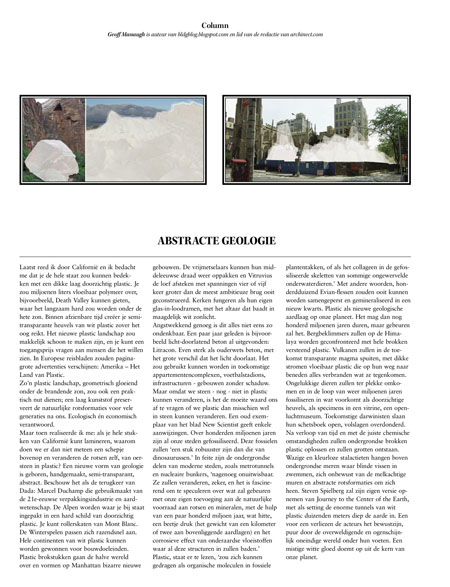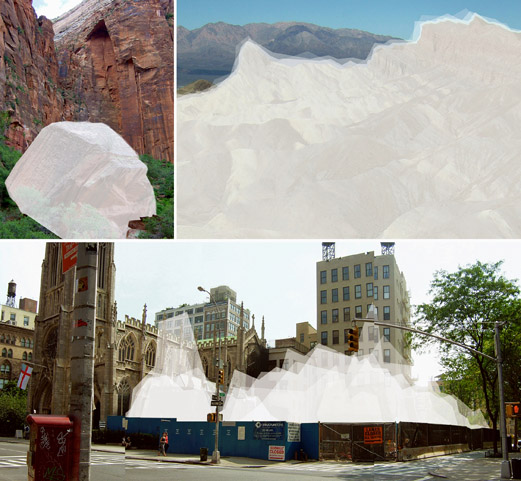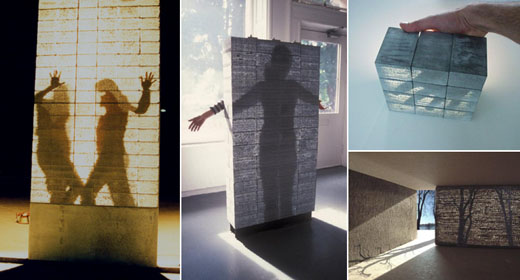 [Image: From Blend, where this post first appeared (translated into Dutch)].
[Image: From Blend, where this post first appeared (translated into Dutch)].On a recent trip through California, it occurred to me that you could cover the entire state in an artificial glacier of translucent plastic, preserving its various landscapes.
For instance, you could pour several million gallons of liquid polymer into Death Valley, where that inland sea of sealant would slowly harden in the state’s dry heat. Soon, you find yourself slipping across semi-transparent slopes of white plastic, extending off to the desert horizon. These new plastic valleys would be easy to clean; you could even charge admission to anyone wishing to see them. Full-page advertisements featuring the white hills of California would immediately appear in European travel magazines: America – A Land in Plastic.
A plasticized landscape – glowing and geometric in the direct light of the sun – would, after all, serve a practical purpose: a layer of plastic could not only preserve but visually enhance natural rock formations, ensuring their stable existence for generations to come.
It would be both ecological and good for the economy.
 [Image: Abstract geology, by BLDGBLOG].
[Image: Abstract geology, by BLDGBLOG].But then I realized: if you could laminate whole stretches of California, why not take a slightly different route and alter rock itself – transforming ancient stone into plastic? A new geology will arrive upon the surface of the earth: manmade, semi-transparent, abstract.
Think of it as the return of Dadaism: Marcel Duchamp meets the 21st-century packaging industry, via the planetary sciences. The Alps, readymade, sealed before your amazed eyes beneath a hard shield of pure white… You could roller-skate down Mt. Blanc. The winter Olympics would be forced to adapt immediately.
The idea, of course, is not without its industrial uses. Whole continents of plastic could be mined for building materials, sculpted into small, white briquettes then shipped halfway round the world to form weird new buildings in Manhattan. Masonry guilds could return to their medieval splendor, outdoing Vitruvius with internal spans four or five times larger than the most ambitious bridge ever constructed. Churches would function as their own stained-glass windows, bathing altarpieces in virginal white.
 [Images: Litracon bricks, via Transmaterial].
[Images: Litracon bricks, via Transmaterial].Excitingly, the realization of this scenario might not be far off.
It was announced several years ago that light-transmitting concrete had been invented. Called Litracon, the new material is equal in strength to regular concrete, yet light passes through it. Litracon could well be used in the construction of future apartment blocks, football stadiums, even urban infrastructure – sewers, roads, and international motorways – all of which would suddenly cast no shadows.
 [Images: Litracon structures, via Litracon and Material Explorer].
[Images: Litracon structures, via Litracon and Material Explorer].But because we can’t turn rock into plastic – yet – it is worth asking how we might turn plastic into rock. A few clues come to us from an old copy of New Scientist. There, we learn how, hundreds of millions of years from now, many of our cities will fossilize. These fossil cities will be “a lot more robust than [fossils] of the dinosaurs.” In fact, the already buried, subterranean undersides of our modern cities, from Tube tunnels to nuclear bunkers, “will be hard to obliterate. They will be altered, to be sure, and it is fascinating to speculate about what will happen to our very own addition to nature’s store of rocks and minerals, given a hundred million years, a little heat, some pressure (the weight of a kilometre or two of overlying sediment) and the catalytic, corrosive effect of the underground fluids in which all of these structures will be bathed.”
Plastics, for instance, “might behave like some of the long-chain organic molecules in fossil plant twigs and branches, or the collagen in the fossilized skeletons of some marine invertebrates.” A hundred thousand Evian bottles, then, may someday transform by compression into a new quartz: vast and subterranean veins of mineralized plastic.
In other words, plastics will, in fact, form a new geological layer upon the earth; plastics will be our future geology. It may take a hundred million years, but it will happen. Future Himalayan adventurers will stumble upon vast belts of plastic, compressed into ribbons between layers of bedrock. Volcanoes of the future will erupt, belching transparent magma – liquid plastic – rolling out in great sheets, boiling everything in their path. Unlucky animals will be entombed there, fossilizing slowly over another million years, till their hardened remains seem to hover inside plastic hillsides, like specimens in a resinous vitrine, an open-air museum. Future Darwins will open their sketchbooks, stunned…
Fantastically, given time and the right chemical composition, underground stratigraphies of white plastic will dissolve, forming caves. Blurred and colorless stalactites will hang over subterranean lakes in which blind fish swim, unaware of the milky walls and abstract rock formations hovering all around them. Steven Spielberg will direct his own version of Journey to the Center of the Earth, setting the film inside enormous tunnels of white plastic extending hundreds of thousands of feet into the planet. One by one, actors will lose consciousness and fall to the ground, passing out in contemplation of the apparently infinite abyss extending for miles beneath their feet… a hazy white glow coming from the very core of the planet.
(Note: Other BLDGBLOG material originally from Blend: Wreck-diving London and The Helicopter Archipelago – and more to come).
No comments:
Post a Comment